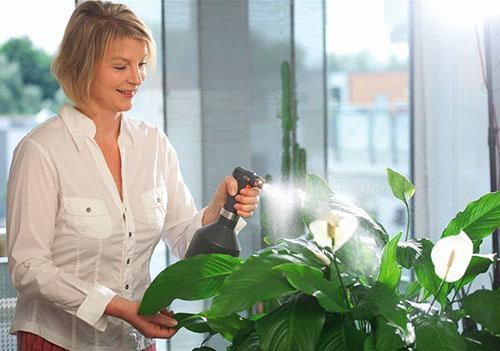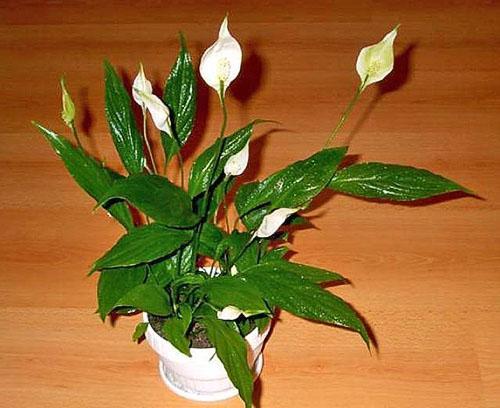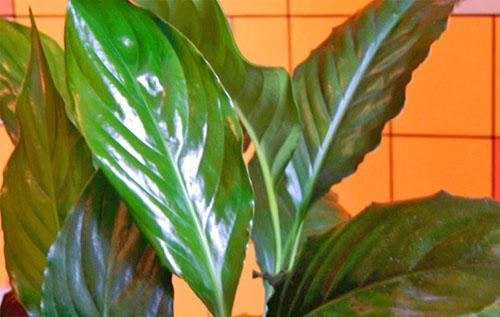Proper care of the indoor plant spathiphyllum and possible difficulties
 The homeland of spathiphyllum is the humid tropics, so keeping in captivity should take into account the characteristics of those places. Our flowers grow there under the canopy of tall trees in partial shade. The wind does not touch them, the air is humid and the leaves are adapted so that excess moisture does not linger and flow down from pointed lanceolate leaves. For decorativeness, caring for a spathiphyllum plant must meet the requirements of nature.
The homeland of spathiphyllum is the humid tropics, so keeping in captivity should take into account the characteristics of those places. Our flowers grow there under the canopy of tall trees in partial shade. The wind does not touch them, the air is humid and the leaves are adapted so that excess moisture does not linger and flow down from pointed lanceolate leaves. For decorativeness, caring for a spathiphyllum plant must meet the requirements of nature.
Avoiding acquisition to breeding

- does not tolerate drafts;
- does not like direct sunlight in summer;
- comfort temperature in winter 16 0, up to 23 in summer, blooms well at 18;
- abundant watering, but without stagnant water;
- spraying leaves during the day;
- annual transplants, and light slightly acidic soil.
Subject to these conditions, the plant will certainly please with annual flowering.
If you have acquired spathiphyllum, how to care for it? The flower must undergo acclimatization and quarantine for two to three weeks. If he drops the leaves a little, watering is required. The place for the plant is chosen immediately and for a long time, he does not like change, a stay-at-home. The east and west windows with shading from direct rays are ideal, the north - the flower suffers in summer, backlighting is needed in winter. With artificial lighting, the plant can thrive in the back of the room.
For a purchased greenhouse plant, you need to transplant into a special soil, or create land for spathiphyllum yourself:
- sod land - 1 hour;
- leaf humus - 1 hour;
- peat - 1 hour;
- sand -1 tsp;
- coniferous bark, charcoal, brick chips, in the amount of 1 tsp.
In addition, you will need expanded clay or ceramic chips and pebbles to create a drainage layer.
 The plant should be watered, removed from the container, slightly gently peeled from the greenhouse soil, placed on a layer of earth on top of the drainage bedding, spread the roots and gradually sprinkled with a new mixture, shaking slightly and tamping with a finger or stick. Water the earth with warm, settled water, wait for the layer to settle and add more. In this case, it is necessary to leave 2 cm to the edge of the pot and not cover the plant above the neck. After transplanting, do not water the plant until new leaves come, but spray the leaves 2 times daily. You can create a mini-boy on top, but provide holes for ventilation.
The plant should be watered, removed from the container, slightly gently peeled from the greenhouse soil, placed on a layer of earth on top of the drainage bedding, spread the roots and gradually sprinkled with a new mixture, shaking slightly and tamping with a finger or stick. Water the earth with warm, settled water, wait for the layer to settle and add more. In this case, it is necessary to leave 2 cm to the edge of the pot and not cover the plant above the neck. After transplanting, do not water the plant until new leaves come, but spray the leaves 2 times daily. You can create a mini-boy on top, but provide holes for ventilation.
 To water woman's happiness you need to plentifully, but at the same time first wait for the top layer of earth in the pot to dry out, and only then water from above or through a pallet. Slightly drooping leaves indicate that the plant needs watering.
To water woman's happiness you need to plentifully, but at the same time first wait for the top layer of earth in the pot to dry out, and only then water from above or through a pallet. Slightly drooping leaves indicate that the plant needs watering.
How to feed spathiphyllum so that it begins to bloom faster - newcomers ask. It should be fed 2 times a month with liquid fertilizers for aroids, while the composition should not prevail nitrogen fertilizers... Occasionally, you can pamper the flower with a weak solution of mullein extract or bird compost. To maintain the humidity around the plant, you need to create a comfort zone. Place an aquarium or a tray next to it with expanded clay and sphagnum moss placed in it, they constantly evaporate the water poured into the bottom of the pan.
 Flower propagates:
Flower propagates:
- layers grown next to the main plant from the ground;
- cuttings;
- seating thickets;
- rhizomes;
- seeds.
The procedure for planting plants with roots does not differ from transplanting purchased specimens. If there are no roots, then you can root the petiole in the sand, covering it with a transparent cap.
Why doesn't spathiphyllum bloom?
 If spathiphyllum receives the wrong care, it will not bloom. There may be several reasons:
If spathiphyllum receives the wrong care, it will not bloom. There may be several reasons:
- the pot where the plant is planted is too voluminous, until it is filled with roots, there will be no flowering;
- low ambient temperature, insufficient humidity;
- the plant is starving, has not been transplanted for a long time and is not fertilized;
- the plant is old or sick.
Blackening, drying out or yellow leaves will become signs of trouble for the plant. In this case, it is necessary to find problems and eliminate them without bringing the plants to death.
 So, if the leaf petioles rot, then this is stem rot when the ground is wet and cold. The plant needs to be transplanted into another pot, removing decaying parts and sprinkling the cut with crushed coal.
So, if the leaf petioles rot, then this is stem rot when the ground is wet and cold. The plant needs to be transplanted into another pot, removing decaying parts and sprinkling the cut with crushed coal.
If a lot of leaves turn yellow, then waterlogging is possible, but if there is no rotting, this is a sign of lack of nutrition or excessive lighting. If only the lower leaves are yellow, you need to adjust the watering. However, if the plant is close to the battery in winter, the leaves may also dry out.
Blackening leaves signal both underfilling and overflow. Perhaps the ground is missing phosphorus, nitrogen. If the tips of the leaves dry up, this indicates dry air, or the plant has not yet taken root after transplantation. These colors can be prescribed for a weekly shower in the bathroom.
Some hobbyists use liquid wax to make the leaves shine. The wax will clog the pores and the leaves will not be able to breathe. The result is clear.
Pests and diseases
 Usually spathiphyllum fights for its life, only giving a signal to the owners about trouble. But if the plant is weakened, it can be colonized by parasites, which are very small, and reveal themselves when creating a large focus of infection.
Usually spathiphyllum fights for its life, only giving a signal to the owners about trouble. But if the plant is weakened, it can be colonized by parasites, which are very small, and reveal themselves when creating a large focus of infection.
 These include the well-known flower pests:
These include the well-known flower pests:
- Aphids, this sap-pumping bag is very prolific and can kill the plant if left unchecked. At home, you can use a soapy solution for rinsing, a shower and the least dangerous drug phytoverm for humans.
- Thrips also breed very quickly. They appear in the summer, brought in through an open window. White puncture spots appear on the leaves. Spray the back of the plate with insecticide.
- The spider mite will announce its presence by the cobweb appearing on the underside of the plate, in which the larvae run like in a cradle. The female is red, the male is almost invisible. Destroy the pest that appears with insecticides and rinse it off in the shower, it is a resident of dry air.
 Pandurs or springtails can start in a pot, another type of aphid, shield aphid, can grow on the leaves. But whatever the pest, the plant takes on a depressed look and stops blooming.
Pandurs or springtails can start in a pot, another type of aphid, shield aphid, can grow on the leaves. But whatever the pest, the plant takes on a depressed look and stops blooming.